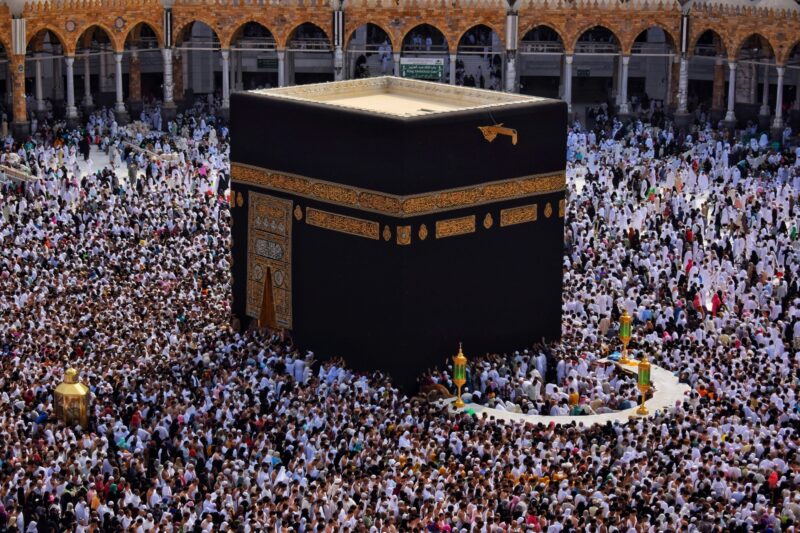Hajj in the heat: from sacred journey to survival test
Extreme heat and humidity led to the tragic deaths of over 1,300 Hajj pilgrims this year. For the Hajj to remain physically possible during summer months, the Saudi government needs to adopt effective adaptation measures and play its part in the global move away from fossil fuels.
Share

The Hajj pilgrimage to Mecca in Saudi Arabia is a lifelong aspiration for every Muslim. In developing countries like Pakistan, where I come from, this dream often requires immense financial sacrifice. Many forgo significant life milestones like buying a house to save enough money for this spiritual journey, which is one of the Five Pillars of Islam.
Yet despite these sacrifices, upon reaching Mecca, devoted, low-income pilgrims face harsh conditions. They are forced to stay in cheap, low quality accommodation far from the holy mosque. They stay in tents during the mandatory five days of the Hajj, with access to only basic cooling like fans or air coolers, unlike wealthier pilgrims who can afford air-conditioned tents.
The strenuous rituals of the Hajj undertaken during 50°C daytime temperatures followed by hot nights poses a severe risk of death. For the Hajj to remain physically possible during summer months, the Saudi government not only needs effective adaptation measures, it must play its part in the global move away from fossil fuels.
The challenge of extreme heat is compounded by the demographics of the pilgrims – nearly half are 56 years’ of age or older, and a significant number have preexisting health conditions. The physical demands of the Hajj, under these extreme conditions, transform what should be a spiritual pinnacle into a dangerous ordeal.
This year, 1.8 million pilgrims travelled to Mecca, 1.6 million of them from across the world. Tragically, over 1,300 of them died from extreme heat stress as they performed the required series of rituals under the blazing sun amid extreme heat and humidity, followed by a night under open skies.
Heat stress occurs when heat and humidity combine, as this interferes with our ability to cool ourselves by sweating. The temperature at the Grand Mosque in Mecca reached 51.8˚C last week, around 5°C hotter than forecast, while relative humidity was 25%. Such conditions put even the lives of young, healthy individuals at risk if exposed for three hours or more.
Our 2021 study on the potential risk of dangerous heat stress during the pilgrimage to Mecca finds that if the world limits global warming to 1.5°C, this would halve the number of heat-related deaths during the Hajj compared with 2°C of warming.
We also found that five-day periods which exceed extremely dangerous heat stress thresholds are most likely to occur in the month of September. The chance of exceeding this threshold during this month would be four times greater in a world that is 1.5°C warmer than pre-industrial levels, and as much as 13 times more likely should global warming reach 2°C.
But this year's Hajj deaths occurred in June. As global warming continues to drive extreme heat, by the time the Hajj cycle moves around the calendar to the hottest months in 2050, it is very doubtful it will be able to continue in the same way.
The world is currently heading to 2.7°C of warming, and there's little sign of governments rushing to take the necessary action to bring down that projected temperature.
Last year, 240 people died at the Hajj, but this year's numbers were much higher, as were the temperatures. The Saudi hosts had medical teams at the ready, and deployed all kinds of adaptation efforts like water misting systems to reduce the threat. But it was clearly not enough to safeguard the 1300 who lost their lives.
Saudi Arabia is the world's fourth biggest fossil fuel exporter, exporting the very product that is driving these heat extremes. While it makes around $150 billion from the Hajj and Umrah per year, the Saudi Kingdom’s profits from fossil fuel are far higher.
Yet the Saudi government is planning to increase the numbers at the Hajj, aiming for 4.5 million people by 2050. And it's not planning to reduce its fossil fuel business.
This kind of disconnect between a country's fossil interests and climate change is not limited to Saudi Arabia. The US is the second largest fossil fuel exporter, its own citizens suffered under a massive heatwave at the same time.
The Hajj pilgrimage is a profound reminder to every Muslim of equality in the eyes of God. It is a time when wealth, race, culture, and gender are stripped away, leaving only one's righteousness to elevate their status. Yet, the disparity in the safety of pilgrims based on their financial means starkly contradicts this spirit of equality.
The elderly and those with health conditions are most vulnerable to harsh conditions during the Hajj. These individuals must be protected, irrespective of their economic status. To honour the spirit of the Hajj and safeguard the most vulnerable, we must act now to adapt while we bring emissions down in line with the Paris Agreement’s 1.5°C warming limit.












